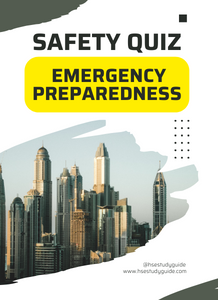Description
Workplace Safety Quiz : Creating a safe and healthy workplace is a shared responsibility that benefits everyone—employees, employers, and communities alike. Our eBook, “Workplace Safety Quiz: A Roadmap to a Safer and Healthier Workplace,” is your comprehensive guide to mastering the principles and practices that are crucial for ensuring safety and well-being in any work environment.
Workplace safety is an essential aspect of any organization, and knowledge is the key to preventing accidents and promoting a culture of safety. This eBook offers an engaging and educational approach to learning about workplace safety through a series of quizzes and questions that cover key aspects of safe practices.
Key Features:
- Interactive Quizzes: Test your knowledge with a wide range of quizzes that cover various aspects of workplace safety. Each question is designed to challenge your understanding and reinforce critical safety concepts.
- Comprehensive Coverage: Explore essential workplace safety topics, including hazard identification, ergonomics, fire safety, emergency response, safety culture, and compliance with safety regulations. Gain a well-rounded understanding of workplace safety principles.
- Real-Life Scenarios: Dive into practical workplace situations where safety knowledge is put to the test. Learn how to recognize potential hazards, make informed decisions, and implement safety measures effectively.
- Safety Guidelines: Receive expert insights and guidance on best practices for workplace safety. Understand the importance of safety training, reporting procedures, and fostering a culture of safety.
- Self-Assessment: Monitor your progress and evaluate your workplace safety expertise with self-assessment tools and answer keys for each quiz.
- Bonus Resources: Access additional workplace safety resources, including checklists, reference materials, and tips for creating a safer work environment.
Whether you’re an employee, a manager, or a safety professional, “Workplace Safety Quiz: A Roadmap to a Safer and Healthier Workplace” is your ultimate reference. Equip yourself with the essential information and skills needed to ensure a safe and healthy work environment, minimize risks, and promote well-being for all.
Challenge yourself, learn, and take the initiative to make your workplace safer and healthier for everyone. Download your copy today and embark on a journey to become a certified workplace safety expert, contributing to a safer, more productive, and happier work environment through knowledge and preparedness.





Reviews
There are no reviews yet.